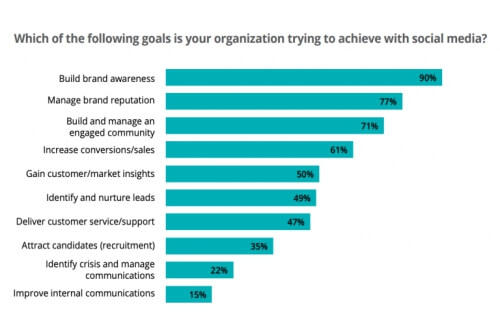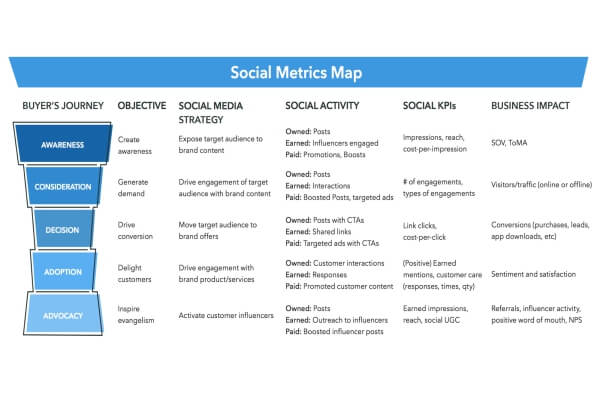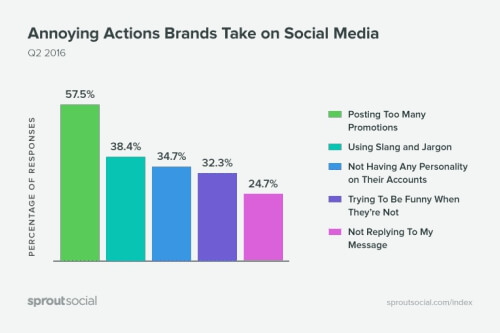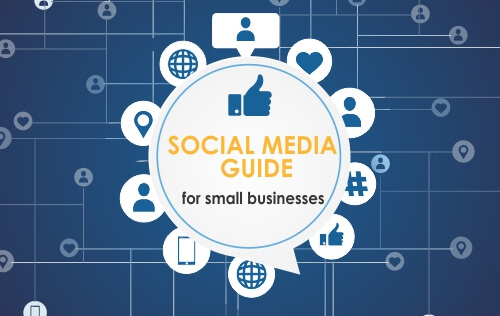According to Datareportal, there are now more than 3.5 billion social media users around the world, representing roughly 46% of the world’s population. Their data also shows that, globally, the average user makes use of more than nine different social media platforms and spends around 2 hours and 16 minutes on social media each day.
This is an enormous audience your business could be losing out on if you have not yet embraced social media as part of your marketing strategy. As a small business owner, you may feel overwhelmed by the potential of social media and unsure of how to make the most of it. In this guide, we will hopefully demystify the topic and help you achieve marketing success on social media.
Start with a plan
Any marketing campaign must start with a plan. It’s important to understand what you want to achieve through social media? Whether you want to increase revenue or create brand awareness, having clear goals from the outset will help you craft the right content at the right time aimed at the right audience. It will also help you measure your performance and determine whether you are getting a return on your investment.
Some of the more popular goals that social media marketers set include:
- Increasing brand awareness
- Growing your audience
- Increasing website traffic
- Improving community engagement
- Generate leads and increase conversions

What you choose as your ultimate goal is up to you – just keep it simple and realistic and make sure that you can measure it. Refer to Hootsuite’s S.M.A.R.T goal framework when setting your goals.
Know your audience
It is critical that you understand who you are targeting with your social media marketing. Who do you want to reach and what kind of posts would resonate with them the most? Which social media platforms do they prefer and how do they use social media?
Research your target audience thoroughly before you begin. There is a wealth of information on the internet regarding social media demographics and usage that can help you make the right decisions for your marketing strategy. Dig deep into your own data as well to discover who is already buying from you and what their pain points are.
Choose your platform
Many businesses make the mistake of thinking they need to be on every conceivable social media platform. This is simply not true and definitely not sustainable. If you’ve done your homework and researched your target audience, you will know which social media platforms they frequent. Also, consider how much time you have to create and publish content. If you are only active on one platform, that is fine – as long as this is the platform where most of your audience is.
Below is a quick overview of the most popular social media platforms:

Establish your key performance metrics
Your social media goals will determine what metrics you use to determine your performance. Now you know what you want to achieve, it becomes easier to know how you will measure this performance
Just be wary of getting caught up in so-called vanity metrics. These are metrics such as likes, followers, subscribers, etc – things that make your brand look good on the surface, but can be meaningless to the achievement of your goals. Always refer to your goals when deciding on your key performance metrics.
All of the social media platforms have their own analytics data that you can delve into. If you’re tight on budget, you can start there, or you can consider using social media analytics tools to help you uncover data. Buffer has put together a list of some of the social media metrics tools available, as well as some information on how to access each platform’s native analytics. You can also find some handy tips on how to measure your performance manually from this guide created by Social Media Examiner.
Sprout Social has created this nifty Social Media Metrics Map, that links your social media goals to the Buyer’s Journey and outlines the most important metrics for each stage and goal.

Check out your competition
Take the time to check out what your competition is doing. What is working well for them and what isn’t. Are they covering content or topics that you are not? What are some of the keywords they use? Keeping an eye on your competition will help you to uncover opportunities and content ideas that can give you an advantage when it comes to your own social media strategy.
Create relevant content
In today’s market, content is king. Your goals and your audience will determine the type of content that you create. The important thing is to create quality content that will be relevant to your audience. Minimise purely promotional content and rather focus on engaging with your audience in a meaningful way. According Sprout Social, 60% of social media users are annoyed by too much promotional content from brands.

Also consider where your audience might be in the Buyer’s Journey and tailor your content accordingly. The following is a list of the types of content that you can post on social media platforms:
- Infographics presents complex information in visual format. Because we process visual information much faster than text, it makes for incredibly engaging and shareable content.
- Interactive content that allows users to engage with your content, such as quizzes, polls, Q&As or contests.
- User-generated content that you curate and publish
- Videos are a social media favourite and comes in different formats such as short form, live streams, podcasts and webinars
- Shareable quotes that reflect your brand values and inspires your audience
- Blogs that link back to your website
- Curated content that provides valuable information about industry trends and news
- Client testimonials will highlight your organisation as a trusted brand
- Downloadable ebooks and guides that help users understand topics or products
- Ephemerial content such as Instagram stories that is only displayed for a short period of time
Draw up a content schedule and consider using automated tools such as Hootsuite or Sprout Social that posts your content automatically according to your schedule. Make sure you post regularly and consistently and be responsive to your audience’s feedback and comments.
Measure your performance & Review your strategy
Measure your performance regularly and consistently, using the metrics you set up.
Take actionable steps on the information revealed by your performance review. Adjust your goals, your metrics or your content where you have fallen short and schedule another review after enough time to give your adjustments time to take effect.
Social media can add greatly to your marketing mix and is especially valuable to small businesses due to its open access and relatively low costs. Understand your goals, your audience and your platforms and you will soon see your efforts pay off.

